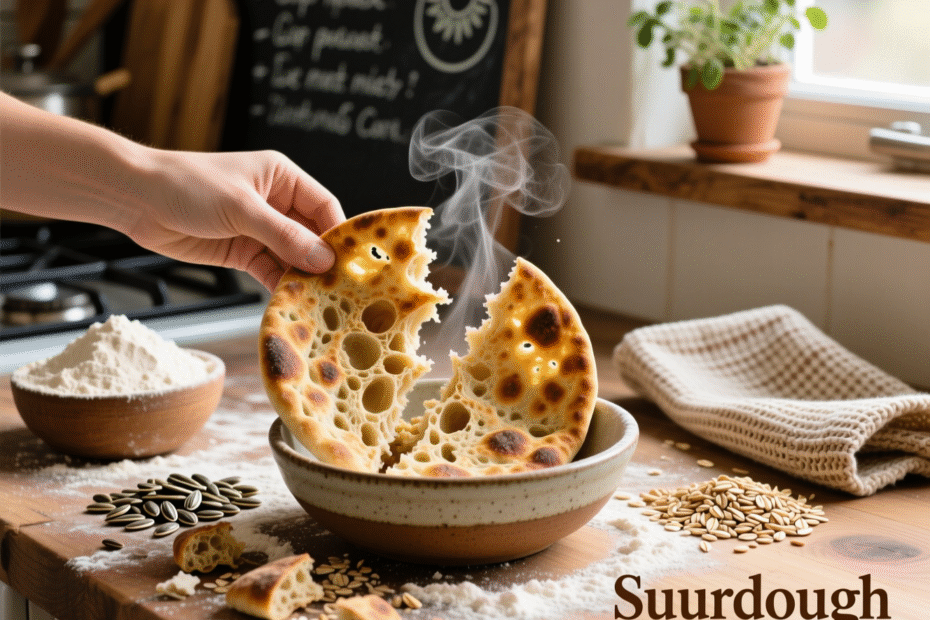What if the “waste” from your sourdough starter could become the star of your next meal? If you’ve ever fed your bubbly sourdough starter and poured the excess down the drain, you’re not alone—but you’re also missing out on a treasure trove of flavor, nutrition, and creativity.
Sourdough discard—the unfed portion of your starter that’s often set aside during routine maintenance—is far from trash. In fact, it’s a versatile, tangy, and slightly fermented ingredient that can transform everything from pancakes to pizza crusts.
In this article, we’ll explore how to turn sourdough discard into delicious, zero-waste recipes that reduce food waste while expanding your culinary repertoire. You’ll discover why sourdough discard is more than just a byproduct, learn practical ways to use it in everyday cooking, and uncover clever ideas that even beginner bakers can master.
Whether you’re a seasoned sourdough enthusiast or just starting your fermentation journey, these recipes and tips will help you make the most of every spoonful—no waste, no guilt, just great food. Let’s dive into the world of sourdough discard and reimagine what “leftovers” can really be.
Why Sourdough Discard Isn’t Waste—It’s an Ingredient
Many home bakers treat sourdough discard as something to toss, but that couldn’t be further from the truth. Sourdough discard is simply unfed starter—a mixture of flour, water, and wild yeast that hasn’t been refreshed recently. While it may not be strong enough to leaven a loaf on its own, it still contains active cultures, complex flavors, and natural acidity that enhance a wide range of recipes.
The tangy, slightly sour taste of discard comes from lactic and acetic acids produced during fermentation. These acids not only add depth to baked goods but also act as natural preservatives, extending shelf life without artificial additives.
Plus, using discard helps reduce food waste—a growing concern in both home and commercial kitchens. According to the United Nations, roughly one-third of all food produced globally is wasted. By repurposing your discard, you’re taking a small but meaningful step toward sustainability.
Think of discard as your kitchen’s secret weapon: it adds moisture to muffins, crispness to crackers, and richness to waffles—all while keeping your compost bin lighter and your conscience clearer. And the best part? You don’t need to wait for your starter to peak or be perfectly active. Even “sleepy” or older discard works beautifully in most recipes.
So before you pour that jar of discard down the sink, remember: it’s not waste. It’s flavor waiting to happen.
Easy Everyday Recipes That Love Sourdough Discard
One of the greatest joys of sourdough discard is how seamlessly it integrates into everyday meals. You don’t need fancy equipment or hours of prep—just a few pantry staples and a willingness to experiment.
Pancakes and waffles are perhaps the most beloved discard recipes. Simply mix ½ to 1 cup of discard with eggs, milk (or a dairy-free alternative), a touch of sweetener, and a pinch of baking soda (which reacts with the acid in the discard to create lift). The result? Fluffy, tangy breakfast treats with a subtle complexity that store-bought mixes can’t match.
Crackers are another no-fail option. Combine discard with olive oil, salt, herbs, and a bit more flour if needed, roll thin, cut into squares, and bake until crisp. They’re perfect for snacking or pairing with cheese—and they keep for weeks in an airtight container.
For lunch or dinner, try sourdough discard pizza dough. While it won’t rise like a traditional yeasted crust, it develops a satisfying chew and deep flavor when given a few hours (or even overnight) to rest. Top it with your favorite veggies, sauce, and cheese for a quick, waste-free weeknight meal.
Even brownies and chocolate cake benefit from discard! The acidity balances sweetness and creates a fudgier texture. Just substitute ½ to 1 cup of discard for part of the flour and liquid in your favorite recipe.
These aren’t just clever hacks—they’re practical, delicious solutions that turn routine maintenance into culinary opportunity. And because most discard recipes are forgiving, they’re perfect for busy days when you want flavor without fuss.
Beyond Baking: Creative (and Unexpected) Uses for Discard
While baked goods are the usual suspects, sourdough discard shines in far more surprising places. Think beyond the oven—and even beyond breakfast.
Have you ever tried sourdough discard in savory sauces or dressings? Its mild acidity makes it a fantastic base for creamy salad dressings or a tangy addition to marinades for chicken or tofu. Whisk it with olive oil, Dijon mustard, garlic, and herbs for a zesty vinaigrette that cuts through rich dishes.
Or consider sourdough discard as a binder in veggie burgers or meatballs. It adds moisture and structure while enhancing umami flavor. Mix it with mashed beans, grated vegetables, spices, and breadcrumbs, then pan-fry or bake for hearty, plant-based patties that hold together beautifully.
Even smoothies can get a probiotic boost from a spoonful of fresh discard (though avoid using very old or moldy discard). Blend it with banana, berries, yogurt, and a drizzle of honey for a gut-friendly morning drink with a subtle tang.
And for the adventurous: sourdough discard pasta. Yes, really! Combine discard with egg and flour to form a dough, roll it thin, and cut into noodles. The result is a rustic, slightly chewy pasta with a nuanced flavor that pairs wonderfully with buttery sauces or fresh tomato.
These unconventional uses prove that discard isn’t limited to sweet treats or bread. It’s a flexible ingredient that adapts to your culinary mood—whether you’re craving comfort food, something fresh, or a little kitchen experimentation.
Storing and Managing Discard for Maximum Freshness
To get the most out of your sourdough discard, proper storage is key. Left at room temperature, discard will continue fermenting and may develop off-flavors or excessive hooch (the amber liquid that forms on top) within a day or two. But with a few simple habits, you can keep it fresh and ready to use for weeks.
Refrigeration is your best friend. Store discard in a clean, airtight container in the fridge. It will slow fermentation dramatically, allowing you to accumulate discard over days or even weeks. Most bakers keep a dedicated “discard jar” and add to it after each feeding. When the jar fills up, it’s time to bake!
If you won’t use it within 1–2 weeks, freeze it. Portion discard into ice cube trays or small freezer bags (½-cup portions work well). Thaw overnight in the fridge before using. Frozen discard may separate slightly, but a quick stir brings it back together.
A few tips for success:
- Label your container with the date to track freshness.
- Stir before using, especially if hooch has formed (you can pour it off or stir it in—it’s harmless).
- Use older discard in cooked recipes (like bread or crackers), and fresher discard in no-bake applications (like dressings or smoothies).
By managing your discard thoughtfully, you ensure it’s always on hand when inspiration strikes—turning potential waste into a well-stocked pantry staple.
The Bigger Picture: How Using Discard Supports Sustainable Baking
Embracing sourdough discard isn’t just about saving money or trying new recipes—it’s part of a larger movement toward mindful, sustainable living. Every time you repurpose discard, you’re reducing food waste, conserving resources, and honoring the ingredients you use.
Consider this: producing one loaf of bread requires water, energy, land, and labor. When we discard edible portions of our ingredients, we indirectly waste all those inputs. By using sourdough discard creatively, we close the loop in our baking cycle, aligning with principles of circular cooking—where nothing goes to waste.
Moreover, sourdough itself is a low-impact fermentation method. Unlike commercial yeast, which is industrially produced, sourdough relies on wild microbes already present in your environment. It’s a return to traditional foodways that value patience, observation, and respect for natural processes.
Using discard also encourages intentional baking. Instead of feeding your starter just to maintain it, you begin to see each feeding as an opportunity—to bake, to nourish, to create. This shift in mindset transforms baking from a chore into a joyful ritual.
In a world where convenience often trumps care, choosing to use every part of your starter is a quiet act of rebellion—and a delicious one at that.
Conclusion: Bake with Purpose, Waste Nothing
Throughout this article, we’ve explored how sourdough discard—often misunderstood as waste—is actually a flavorful, functional, and sustainable ingredient. From fluffy pancakes and crispy crackers to savory sauces and homemade pasta, discard opens up a world of culinary possibilities that reduce waste without sacrificing taste or convenience.
We’ve seen that managing discard is simple with proper storage, that it enhances both sweet and savory dishes, and that using it aligns with broader values of sustainability and mindful consumption. Most importantly, we’ve learned that baking doesn’t have to generate waste to be rewarding.
So the next time you feed your starter and set aside that “extra,” don’t think of it as something to throw away. Think of it as your kitchen’s hidden gem—ready to add depth, tang, and soul to your next meal.
Now it’s your turn! Have you tried any sourdough discard recipes? Do you have a favorite way to use it? Share your creations, tips, or questions in the comments below—we’d love to hear how you’re turning “waste” into wonder. And if you haven’t experimented yet, pick one recipe from this list and give it a go this week. Your starter (and your taste buds) will thank you.
After all, in the world of sourdough, there’s no such thing as waste—only ingredients waiting for their moment to shine.

Thayná Alves is an influential digital content creator who has carved out a significant space in the realms of technology, finance, and entrepreneurship. Through her blog, Newbacker.com , she stands out as an authentic and accessible voice for individuals seeking practical information about investments, innovation, and emerging trends in the financial market.
